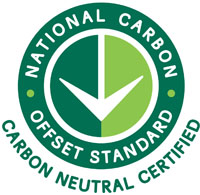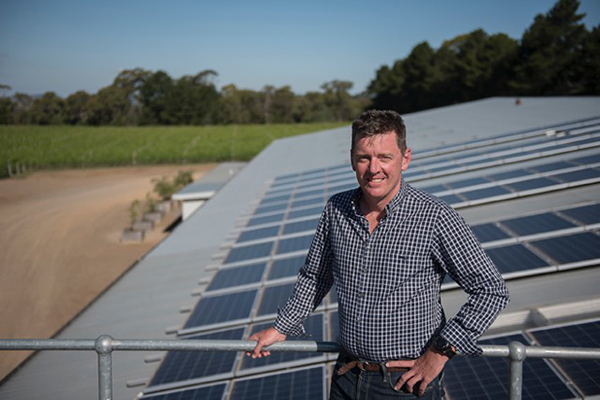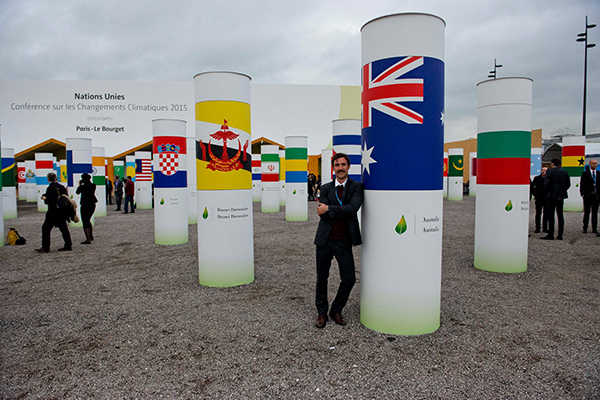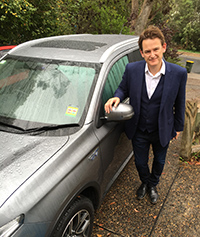News stories
- NCOS expands: Australian Government certification is here to stay
- Carbon neutrality: now business as usual for many
- Simply taking action – a big shout out to carbon neutral SMEs
- M&V update: Pangolin creates first HVAC-approved methodology in NSW
- Did you know? We also provide CDP reporting services
- Low emission driving: plug-in hybrids v hybrids
Missing out on our sustainability news?
We send newsletters periodically. Subscribe to our newsletter right here.
NCOS expands
Australian Government certification is here to stay
 Expect to see more about the National Carbon Offset Standard (NCOS) in the news. Last month Federal Minister for the Environment, Greg Hunt, announced that NCOS certification for carbon neutrality is to expand from products and organisations, to buildings, precincts and indeed entire cities. An expert committee will start the process this month, setting criteria and guidelines for the expanded certification, available as early as 2017. Sydney’s Barangaroo precinct is expected to meet NCOS obligations, as well as the City of Adelaide, SA. Once it succeeds, Adelaide will set a world’s first.
Expect to see more about the National Carbon Offset Standard (NCOS) in the news. Last month Federal Minister for the Environment, Greg Hunt, announced that NCOS certification for carbon neutrality is to expand from products and organisations, to buildings, precincts and indeed entire cities. An expert committee will start the process this month, setting criteria and guidelines for the expanded certification, available as early as 2017. Sydney’s Barangaroo precinct is expected to meet NCOS obligations, as well as the City of Adelaide, SA. Once it succeeds, Adelaide will set a world’s first.
At the organisational level, we continue to see growing interest in the Australian Government-approved standard, in industries across the spectrum. NCOS is a rigorous exercise and a significant achievement, so organisations tend to apply for certification in stages, segmenting the overall task into areas such as operations, products and services. Expansion across the organisation typically follows.
Ross Hill Wines, NSW: NCOS success in stages

An example is Orange winery, Ross Hill Wine Group, awarded certification in late 2015. Ross Hill is the first Australian winery to receive NCOS certification, in this instance certifying its operations. We are now working with Ross Hill to expand carbon neutral certification to its products. Ross Hill is a successful example of using low carbon practices in the wine making industry. Congratulations Ross Hill.
- See more about Ross Hill in our press release
- Read Leichhardt Council case study, another organisation successfully achieving NCOS certification
- Check out other NCOS-certified carbon neutral organisations (Australian Government website)
Other changes to the NCOS process
Sequence of NCOS criteria:
There has been a change to the sequence of the NCOS application process. Previously applicants underwent a carbon footprint prior to carbon offsetting, measuring greenhouse gas emissions and establishing a reduction plan first. NCOS now requires offsetting up front, based on the previous year’s emissions. A true-up follows as required. In this way an organisation has truly carried out carbon neutrality in advance of the NCOS application.
Carbon Market Institute:
NCOS has also outsourced the market development aspect of its program to the Carbon Market Institute (CMI), of which Pangolin Associates is a member. CMI provides information through activities such as industry roadshows and information sessions.
Talk to us about NCOS
Pangolin Associates is a leading provider of NCOS services. We have worked with Australian Government-accredited carbon neutral programs since its inception, including the predecessor of NCOS, the Greenhouse Friendly program. Contact us with your questions, or to request our NCOS Process Guide.
Carbon neutrality
Now business as usual for many
In addition to the growing interest in NCOS, requests for carbon offsetting, a part of NCOS but often done on its own, is on the rise — again across the spectrum of industries.
Choice in your offsetting actions
You can choose your carbon credits from a variety of projects that we support.
Primarily we supply credits created under two global standards: the Verified Carbon Standard (VCS) and Gold Standard (GS VER). These standards support forest conservation and renewable energy, such as wind, run-of-river hydro schemes, and fuel switching.
As well as generating clean energy and reducing greenhouse gas emissions, carbon credit programs foster stronger, more productive communities. Accredited projects typically create temporary and permanent job opportunities, and provide a greater understanding of the benefits of sustainable industry at a local level.
To understand more about the accredited abatement projects available through our services, read on.
Examples of carbon credit projects

Just a few projects we support:
Forest conservation | Run-of-river hydropower | Wind energy generation | Fuel switching
Forest conservation: Forests Alive, Australia
Forests Alive projects conserve native Tasmanian forests. Together they protect over 15,000 hectares from logging, and prevent approximately 220,000 tonnes of greenhouse gas emissions annually. They also provide an alternative and sustainable income for farmers and landowners.
Forest conservation: Rimba Raya Biodiversity Reserve Project, Indonesia
InfiniteEARTH initiated this biodiversity project, conserving more than 91,000 hectares of tropical peat swampland. Located on Borneo’s south coast, the project protects a flora and fauna-rich area, which includes the endangered Bornean orangutan.
Run-of-river hydropower: Gansu Province, China
This project, called the Gansu Zhangye Heihe Longhui Small Scale Hydropower, operates in the Sunan County of Gansu Province in northwest China. The project consists of two 6.5 MW turbines, supplying over 50,000 MWh of electricity to the grid annually.
Wind turbines: Tamil Nadu, India
With 12 turbines of 500 kW, the REI Agro project harnesses wind power and has a capacity of 6 MW. The project reduces greenhouse gas emissions by approximately 15,500 tonnes annually. On average, electricity generation is over 16,630 MWh per year.
Fuel switching: Siam Cement Biomass Project, Thailand
SCG Cement Co. Ltd. houses this biomass project using technologies that reduce greenhouse gas emissions in carbon intensive cement manufacturing. All five initiatives in the project use alternate fuels, which includes biomass power.
Carbon offsetting and creating infrastructure with a lighter footprint
One example is Transport for NSW and the Sydney Metro Northwest Skytrain. This is a 4 km rail project to run between Bella Vista and Rouse Hill. Builders Salini Impregilo will construct the rail, bridges and embankment work.
Reducing the environmental impact of infrastructure projects, including with carbon abatement, is a NSW Government mandate. Salini Impregilo has offset approximately 20% of the electricity they will use during construction of the Skytrain with certified carbon credits. Pangolin provided the carbon credit services.
Simply taking action
A big shout out to carbon neutral SMEs

Some proactive SMEs do not undergo the rigours of an NCOS application, but still achieve carbon neutrality (*though not Australian Government certified carbon neutrality).
Following the Paris Climate Change Conference (COP21 2015), these smaller organisations are taking positive action on climate change. We would like to say to them, good on you and a hearty congratulations. Here’s a few of our newest carbon neutral SME clients.
Legal services firm, Clearpoint Counsel.
Corporate massage specialists, Seated Massage.
Energy management company, Energywise (a Pangolin Associates trusted partner).
M&V update
Pangolin creates the first HVAC-approved methodology in NSW

A follow up to the M&V update in our last newsletter: new funding available.
IPART has approved the first energy savings activity under the new PIAM&V methodology.
Our own Certified Measurement and Verification Professional (CMVP), Dr Davide Ross, created the methodology, also known as a Recognised Energy Savings Activity, or RESA, in conjunction with our  trusted partner Ecovantage.
trusted partner Ecovantage.
The NSW Office of Environment and Heritage (OEH) funded the project, which allows Energy Savings Certificate (ESC) generation under the NSW Energy Savings Scheme (ESS). ESS provides funding for businesses implementing energy efficiency initiatives. Now with the new methodology, government initiatives include HVAC upgrades and optimisation. In this activity, the RESA uses AerisGuard anti-microbial multi-enzyme technology in air conditioning systems, which improves air quality and reduces electricity consumption.
PIAM&V and Energy Savings Certificates
Project Impact Assessment with Measurement and Verification methodology (PIAM&V) validates a project’s approach, prior to submission to IPART. PIAM&V is a means to calculate energy savings for ESCs. PIAM&V is a push from the Office of Environment and Heritage to introduce a more thorough methodology for the certificates using international protocols for M&V, rather than predefined calculations (deemed methodology). The certificates are created on the actual energy savings achieved.
M&V: benefits for state and federal programs
M&V helps businesses achieve finance through both NSW Energy Savings Certificates, and the Australian Government’s Emissions Reduction Fund. The service provides assurance that a business’ equipment improves energy efficiency as predicted. This is a critical step when upgrading or investing in new facilities and machinery.
Did you know?
We also provide CDP reporting services
 Are you interested in reporting to the global climate change initiative, CDP? Formerly known as the Carbon Disclosure Project, now simply CDP, this is the most comprehensive source of corporate climate change data. We encourage our corporate clients to support CDP, and to join the 5,500+ worldwide that have disclosed information, such as carbon reporting.
Are you interested in reporting to the global climate change initiative, CDP? Formerly known as the Carbon Disclosure Project, now simply CDP, this is the most comprehensive source of corporate climate change data. We encourage our corporate clients to support CDP, and to join the 5,500+ worldwide that have disclosed information, such as carbon reporting.
Along with NCOS requirements, our carbon footprint measurement aligns with CDP, so it becomes a more straightforward and streamlined way to participate in both programs. Our auditors are accredited for third party verification services for both processes, should you already have a carbon measurement report under either program.
Why report to CDP?
According to the CDP, the number of companies reporting emissions reduction actions has grown from 47% to 89%. The organisation requests all ASX 200 companies to report, although any large entities are encouraged to do so. Leaders of many smaller organisations also choose to participate for CSR purposes.
Disclosure and associated actions demonstrate support for sustainability, including third party and supply chain management. It is a direction increasingly demanded by shareholders. It is important to know that reporting once becomes information available to global investors.
Reporting to CDP tells your customers and employees that you are in line with actions supported by the most powerful organisations. CDP points out that 20% of global emissions are now reported through them. Read more on the CDP website.
Low emission driving: plug-in hybrids v hybrids
Over the summer, two of our Founding Directors, Adelaide based Davide Ross and Sydney Managing Director Iain Smale, trialed and reviewed the Mitsubishi PHEV Outlander, courtesy of Mitsubishi Australia.

The Mitsubishi Plug In Hybrid Electric Vehicle (PHEV) is different to the well-known hybrid, the Toyota Prius (also driven by a company Director). The former plugs in to a standard power socket, which provides an extended petrol-free range, typically about 50 km. Once exceeded, the vehicle operates like the Prius hybrid system. The Outlander has the added advantage of off road capabilities, with a 2nd, on call electric engine positioned over the rear wheels. Iain Smale points out that during one journey, utilising some of the Outlander’s smart features, the vehicle managed an impressive 2.2 L/100km.
With daily access to a power point, and particularly when combined with home solar or the purchase of 100% GreenPower, the Outlander is a great emissions-free (and petrol-cost free) option for a typical daily commute. It is a great choice for extra capacity or off road ability.
For drivers without access to charging points and who frequently stop/start, the Toyota Prius (or its counterparts such as the Toyota Camry Hybrid, Honda Accord Hybrid and Lexus Hybrids) is an excellent, and likely better solution. At low speeds with a charged battery, the car operates in pure electric mode for approximately 500m up to 40km/h. Once up to speed the petrol engine kicks in. On deceleration and cruising down steep hills, the Prius battery recharges, ready for the next bit of acceleration, and smoothing out fuel consumption.
Other manufacturers will offer similar options, such as a new Hyundai IONIQ, available later this year which will have versions of hybrid, PHEV and fully electric. Hyundai is also trialing a hydrogen-powered vehicle in Australia. Until fueling stations and commercial means of producing hydrogen become widespread, hydrogen is rather far down the road for the average driver.
Interestingly, this month luxury electric car maker, Tesla Motors, has recorded in excess of 250,000 orders for its new EV. The Model 3 is touted “the electric car for the people.”
Plug-in hybrid driver, Jon Dee says…

“As industry perfects the batteries needed for long range 300km electric-only driving, plug-in hybrid cars are a great transition alternative. The technology is cleaner and quieter, and contributes to better health in Australia’s cities and towns.
For me plug-in hybrids can give us the best of both of worlds. For short journeys when I’m driving electric, I’m not contributing to local air pollution. For longer trips when I’m shooting Sky News stories, I’ve got no range anxiety as I can use the Outlander’s fuel-efficient hybrid petrol capability.”
Jon Dee is the Anchor Host of Smart Money, a Sky News Money program. He is also the Founder of DoSomething. Jon recently trialled the Mitsubishi Outlander PHEV plug-in hybrid. He has since decided to lease the vehicle.
Update on the PHEV: Plug-in Hybrid Electric Vehicle
See more on Mitsubishi’s Outlander PHEV.
